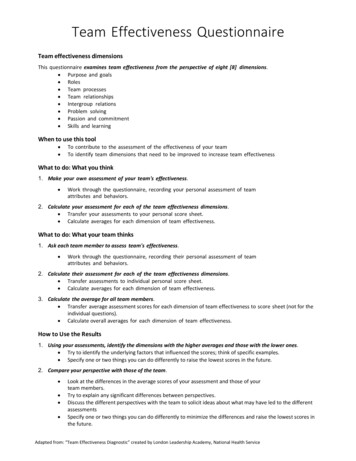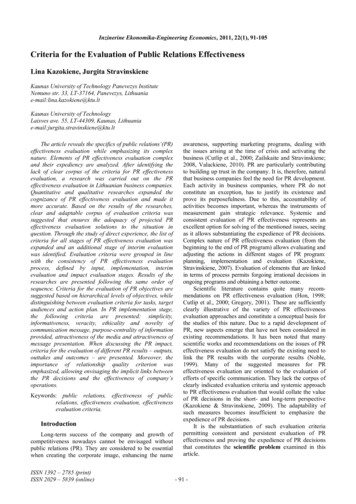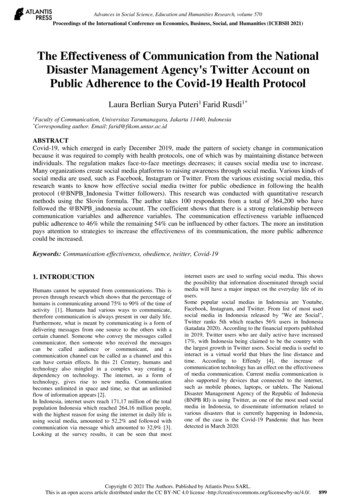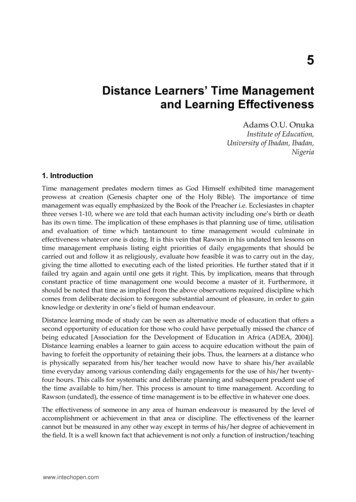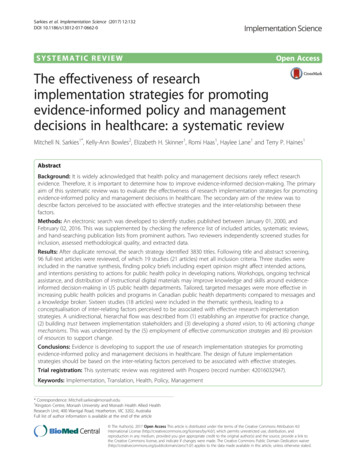
Transcription
Sarkies et al. Implementation Science (2017) 12:132DOI 10.1186/s13012-017-0662-0SYSTEMATIC REVIEWOpen AccessThe effectiveness of researchimplementation strategies for promotingevidence-informed policy and managementdecisions in healthcare: a systematic reviewMitchell N. Sarkies1*, Kelly-Ann Bowles2, Elizabeth H. Skinner1, Romi Haas1, Haylee Lane1 and Terry P. Haines1AbstractBackground: It is widely acknowledged that health policy and management decisions rarely reflect researchevidence. Therefore, it is important to determine how to improve evidence-informed decision-making. The primaryaim of this systematic review was to evaluate the effectiveness of research implementation strategies for promotingevidence-informed policy and management decisions in healthcare. The secondary aim of the review was todescribe factors perceived to be associated with effective strategies and the inter-relationship between thesefactors.Methods: An electronic search was developed to identify studies published between January 01, 2000, andFebruary 02, 2016. This was supplemented by checking the reference list of included articles, systematic reviews,and hand-searching publication lists from prominent authors. Two reviewers independently screened studies forinclusion, assessed methodological quality, and extracted data.Results: After duplicate removal, the search strategy identified 3830 titles. Following title and abstract screening,96 full-text articles were reviewed, of which 19 studies (21 articles) met all inclusion criteria. Three studies wereincluded in the narrative synthesis, finding policy briefs including expert opinion might affect intended actions,and intentions persisting to actions for public health policy in developing nations. Workshops, ongoing technicalassistance, and distribution of instructional digital materials may improve knowledge and skills around evidenceinformed decision-making in US public health departments. Tailored, targeted messages were more effective inincreasing public health policies and programs in Canadian public health departments compared to messages anda knowledge broker. Sixteen studies (18 articles) were included in the thematic synthesis, leading to aconceptualisation of inter-relating factors perceived to be associated with effective research implementationstrategies. A unidirectional, hierarchal flow was described from (1) establishing an imperative for practice change,(2) building trust between implementation stakeholders and (3) developing a shared vision, to (4) actioning changemechanisms. This was underpinned by the (5) employment of effective communication strategies and (6) provisionof resources to support change.Conclusions: Evidence is developing to support the use of research implementation strategies for promotingevidence-informed policy and management decisions in healthcare. The design of future implementationstrategies should be based on the inter-relating factors perceived to be associated with effective strategies.Trial registration: This systematic review was registered with Prospero (record number: 42016032947).Keywords: Implementation, Translation, Health, Policy, Management* Correspondence: Mitchell.sarkies@monash.edu1Kingston Centre, Monash University and Monash Health Allied HealthResearch Unit, 400 Warrigal Road, Heatherton, VIC 3202, AustraliaFull list of author information is available at the end of the article The Author(s). 2017 Open Access This article is distributed under the terms of the Creative Commons Attribution 4.0International License (http://creativecommons.org/licenses/by/4.0/), which permits unrestricted use, distribution, andreproduction in any medium, provided you give appropriate credit to the original author(s) and the source, provide a link tothe Creative Commons license, and indicate if changes were made. The Creative Commons Public Domain Dedication o/1.0/) applies to the data made available in this article, unless otherwise stated.
Sarkies et al. Implementation Science (2017) 12:132BackgroundThe use of research evidence to inform health policy isstrongly promoted [1]. This drive has developed with increased pressure on healthcare organisations to deliverthe most effective health services in an efficient andequitable manner [2]. Policy and management decisionsinfluence the ability of health services to improve societal outcomes by allocating resources to meet healthneeds [3]. These decisions are more likely to improveoutcomes in a cost-efficient manner when they are basedon the best available evidence [4–8].Evidence-informed decision-making refers to the complex process of considering the best available evidencefrom a broad range of information when deliveringhealth services [1, 9, 10]. Policy and management decisions can be influenced by economic constraints, community views, organisational priorities, political climate,and ideological factors [11–16]. While these elementsare all important in the decision-making process, without the support of research evidence they are an insufficient basis for decisions that affect the lives of others[17, 18].Recently, increased attention has been given to implementation research to reduce the gap between researchevidence and healthcare decision-making [19]. Thisgrowing but poorly understood field of science aims toimprove the uptake of research evidence in healthcaredecision-making [20]. Research implementation strategies such as knowledge brokerage and education workshops promote the uptake of research findings intohealth services. These strategies have the potential tocreate systematic, structural improvements in healthcaredelivery [21]. However, many barriers exist to successfulimplementation [22, 23]. Individuals and health servicesface financial disincentives, lack of time or awareness oflarge evidence resources, limited critical appraisal skills,and difficulties applying evidence in context [24–30].It is important to evaluate the effectiveness of implementation strategies and the inter-relating factors perceived to be associated with effective strategies. Previousreviews on health policy and management decisions havefocussed on implementing evidence from single sourcessuch as systematic reviews [29, 31]. Strategies that involved simple written information on accomplishablechange may be successful in health areas where there isalready awareness of evidence supporting practicechange [29]. Re-conceptualisation or improved methodological rigor has been suggested by Mitton et al. toproduce a richer evidence base for future evaluation,however only one high-quality randomised controlledtrial has been identified since [9, 32, 33]. As such, an updated review of emerging research in this topic is neededto inform the selection of research implementation strategies in health policy and management decisions.Page 2 of 20The primary aim of this systematic review was toevaluate the effectiveness of research implementationstrategies for promoting evidence-informed policy andmanagement decisions in healthcare. A secondary aim ofthe review was to describe factors perceived to be associated with effective strategies and the inter-relationshipbetween these factors.MethodsIdentification and selection of studiesThis systematic review was registered with Prospero (recordnumber: 42016032947) and has been reported consistentwith the Preferred Reporting Items for Systematic Reviewsand Meta-Analysis (PRISMA) guidelines (Additional file 1).Ovid MEDLINE, Ovid EMBASE, PubMed, CINAHL Plus,Scopus, Web of Science Core Collection, and The CochraneLibrary were searched electronically from January 01, 2000,to February 02, 2016, in order to retrieve literature relevantto the current healthcare environment. The search waslimited to the English language, and terms relevant to thefield, population, and intervention were combined(Additional file 2). Search terms were selected based on theirsensitivity, specificity, validity, and ability to discriminate implementation research articles from non-implementationresearch articles [34–36]. Electronic database searches weresupplemented by cross-checking the reference list ofincluded articles and systematic reviews identified duringthe title and abstract screening. Searches were also supplemented by hand-searching publication lists from prominentauthors in the field of implementation science.Study selectionType of studiesAll study designs were included. Experimental andquasi-experimental study designs were included to address the primary aim. No study design limitations wereapplied to address the secondary aim.PopulationThe population included individuals or bodies who maderesource allocation decisions at the managerial, executive, or policy level of healthcare organisations or government institutions. Broadly defined as healthcarepolicy-makers or managers, this population focuses ondecision-making to improve population health outcomesby strengthening health systems, rather than individualtherapeutic delivery. Studies investigating clinicians making decisions about individual clients were excluded, unless these studies also included healthcare policy-makersor managers.InterventionsInterventions included research implementation strategies aimed at facilitating evidence-informed decision-
Sarkies et al. Implementation Science (2017) 12:132making by healthcare policy-makers and managers. Implementation strategies may be defined as methods toincorporate the systematic uptake of proven evidenceinto decision-making processes to strengthen health systems [37]. While these interventions have been describeddifferently in various contexts, for the purpose of thisreview, we will refer to these interventions as ‘research implementation strategies’.Type of outcomesThis review focused on a variety of possible outcomesthat measure the use of research evidence. Outcomeswere broadly categorised based on the four levels ofKirkpatrick’s Evaluation Model Hierarchy: level 1—reaction (e.g. change in attitude towards evidence), level2—learning (e.g. improved skills acquiring evidence),level 3—behaviour (e.g. self-reported action taking), andlevel 4—results (e.g. change in patient or organisationaloutcomes) [38].ScreeningThe web-based application Covidence (Covidence,Melbourne, Victoria, Australia) was used to manage references during the review [39]. Titles and abstracts wereimported into Covidence and independently screened bythe lead investigator (MS) and one of two other reviewers (RH, HL). Duplicates were removed throughoutthe review process using Endnote (EndNote , Philadelphia, PA, USA), Covidence and manually during reference screening. Studies determined to be potentiallyrelevant or whose eligibility was uncertain were retrievedand imported to Covidence for full-text review. The leadinvestigator (MS) and one of two other reviewers (RH,HL) then independently assessed the full-text articles forthe remaining studies to ascertain eligibility for inclusion. A fourth reviewer (KAB) independently decided oninclusion or exclusion if there was any disagreement inthe screening process. Attempts were made to contactauthors of studies whose full-text articles were unable tobe retrieved, and those that remained unavailable wereexcluded.Quality assessmentExperimental study designs, including randomised controlled trials and quasi-experimental studies, were independently assessed for risk of bias by the leadinvestigator (MS) and one of two other reviewers (RH,HL) using the Cochrane Collaboration’s tool for assessing risk of bias [40]. Non-experimental study designswere independently assessed for risk of bias by the leadinvestigator (MS) and one of two other reviewers (RH,HL) using design-specific risk-of-bias-critical appraisaltools: (1) Quality Assessment Tool for ObservationalCohort and Cross-Sectional Studies from the NationalPage 3 of 20Heart, Lung, and Blood Institute (NHLBI; [41], February)and (2) Critical Appraisal Skills Program (CASP) QualitativeChecklist for qualitative, case study, and evaluationdesigns [42].Data extractionData was extracted using a standardised, piloted data extraction form developed by reviewers for the purpose ofthis study (Additional file 3). The lead investigator (MS)and one of two other reviewers (RH, HL) independentlyextracted data relating to the study details, design, setting, population, demographics, intervention, and outcomes for all included studies. Quantitative results werealso extracted in the same manner from experimentalstudies that reported quantitative data relating to the effectiveness of research implementation strategies in promoting evidence-informed policy and managementdecisions in healthcare. Attempts were made to contactauthors of studies where data was not reported or clarification was required. Disagreement between investigatorswas resolved by discussion, and where agreement couldnot be reached, an independent fourth reviewer (KAB)was consulted.Data analysisA formal meta-analysis was not undertaken due to thesmall number of studies identified and high levels of heterogeneity in study approaches. Instead, a narrative synthesis of experimental studies evaluating the effectivenessof research implementation strategies for promotingevidence-informed policy and management decisions inhealthcare and a thematic synthesis of non-experimentalstudies were performed to describe factors perceived to beassociated with effective strategies and the interrelationship between these factors. Experimental studieswere synthesised narratively, defined as studies reportingquantitative results with both an experimental and comparison group. This included specified quasi-experimentaldesigns, which report quantitative before and after resultsfor primary outcomes related to the effectiveness of research implementation strategies for promoting evidenceinformed policy and management decisions in healthcare.Non-experimental studies were synthesised thematically,defined as studies reporting quantitative results withoutboth an experimental and control group, or studiesreporting qualitative results. This included quasiexperimental studies that do not report quantitative beforeand after results for primary outcomes related to the effectiveness of research implementation strategies for promoting evidence-informed policy and managementdecisions in healthcare.The thematic synthesis was informed by inductive thematic approach for data referring to the factors perceived to be associated with effective strategies and the
Sarkies et al. Implementation Science (2017) 12:132inter-relationship between these factors. The thematicsynthesis in this systematic review was based onmethods described by Thomas and Harden [43].Methods involved three stages of analysis: (1) line-byline coding of text, (2) inductive development of descriptive themes similar to those reported in primary studies,(3) analytical themes representing new interpretive constructs undeveloped within studies but apparent betweenstudies once data is synthesised. Data reported in theresults section of included studies were reviewed lineby-line and open coded according to meaning and content by the lead investigator (MS). Codes were developedusing an inductive approach by the lead investigator(MS) and a second reviewer (TH). Concurrent with dataanalysis, this entailed constant comparison, ongoing development, and comparison of new codes as each studywas coded. Immersing reviewers in the data, reflexiveanalysis, and peer debriefing techniques were used to ensure methodological rigor throughout the process. Codesand code structure was considered finalised at point oftheoretical saturation (when no new concepts emergedfrom a study). A single researcher (MS) was chosen toconduct the coding in order to embed the interpretationof text within a single immersed individual to act as aninstrument of data curation [44, 45]. Simultaneous axialcoding was performed by the lead investigator (MS) anda second reviewer (TH) during the original open codingof data to identify relationships between codes and organise coded data into descriptive themes. Once descriptive themes were developed, the two investigators thenorganised data across studies into analytical themesusing a deductive approach by outlining relationshipsand interactions between codes across studies. To ensuremethodological rigor, a third reviewer (JW) was consulted via group discussion to develop final consensus.The lead author (MS) reviewed any disagreements in descriptive and analytical themes by returning to the original open codes. This cyclical process was repeateduntil themes were considered to sufficiently describe thefactors perceived to be associated with effective strategies and the inter-relationship between these factors.Page 4 of 20screening (see Additional file 4 for the full list of 96 articles). The full-text of these 96 articles was then reviewed,with 19 studies (n 21 articles) meeting all relevant criteria for inclusion in this review [9, 27, 46–64]. The mostcommon reason for exclusion upon full-text review wasthat articles did not examine the effect of a research implementation strategy on decision-making by healthcarepolicy-makers or managers (n 22).Characteristics of included studiesThe characteristics of included studies are shown inTable 1. Three experimental studies evaluated the effectiveness of research implementation strategies for promoting evidence-informed policy and management decisionsin healthcare systems. Sixteen non-experimental studiesdescribed factors perceived to be associated with effectiveresearch implementation strategies.Study designOf the 19 included studies, there were two randomisedcontrolled trials (RCTs) [9, 46], one quasi-experimentalstudy [47], four program evaluations [48–51], three implementation evaluations [52–54], three mixed methods[55–57], two case studies [58, 59], one survey evaluation[63], one process evaluation [64], one cohort study [60],and one cross-sectional follow-up survey [61].Participants and settingsThe largest number of studies were performed in Canada(n 6), followed by the United States of America (USA)(n 3), the United Kingdom (UK) (n 2), Australia(n 2), multi-national (n 2), Burkina Faso (n 1), theNetherlands (n 1), Nigeria (n 1), and Fiji (n 1). Healthtopics where research implementation took place were varied in context. Decision-makers were typically policymakers, commissioners, chief executive officers (CEOs),program managers, coordinators, directors, administrators,policy analysts, department heads, researchers, changeagents, fellows, vice presidents, stakeholders, clinical supervisors, and clinical leaders, from the government, academia,and non-government organisations (NGOs), of varyingeducation and experience.ResultsSearch resultsResearch implementation strategiesThe search strategy identified a total of 7783 articles,7716 were identified by the electronic search strategy, 56from reference checking of identified systematic reviews,8 from reference checking of included articles, and 3 articles from hand-searching publication lists of prominentauthors. Duplicates (3953) were removed using Endnote(n 3906) and Covidence (n 47), leaving 3830 articlesfor screening (Fig. 1).Of the 3830 articles, 96 were determined to be potentially eligible for inclusion after title and abstractThere was considerable variation in the research implementation strategies evaluated, see Table 2 for summarydescription. These strategies included knowledge brokering [9, 49, 51, 52, 57], targeted messaging [9, 64],database access [9, 64], policy briefs [46, 54, 63], workshops [47, 54, 56, 60], digital materials [47], fellowshipprograms [48, 50, 59], literature reviews/rapid reviews[49, 56, 58, 61], consortium [53], certificate course [54],multi-stakeholder policy dialogue [54], and multifacetedstrategies [55].
Sarkies et al. Implementation Science (2017) 12:132Page 5 of 20Fig. 1 PRISMA Flow DiagramQuality/risk of biasExperimental studiesThe potential risk of bias for included experimentalstudies according to the Cochrane Collaboration tool forassessing risk of bias is presented in Table 3. None ofthe included experimental studies reported methods forallocation concealment, blinding of participants andpersonnel, and blinding of outcome assessment [9, 46,47]. Other potential sources of bias were identified ineach of the included experimental studies including (1)inadequate reporting of p values for mixed-effectsmodels, results for hypothesis two, and comparison ofhealth policies and programs (HPP) post-intervention onone study [9], (2) pooling of data from both interventionand control groups limited ability to evaluate the successof the intervention in one study [47], and (3) inadequatereporting of analysis and results in another study[46]. Adequate random sequence generation wasreported in two studies [9, 46] but not in one [47].One study reported complete outcome data [9]; however,large loss to follow-up was identified in two studies[46, 47]. It was unclear whether risk of selectivereporting bias was present for one study [46], as outcomes were not adequately pre-specified in the study.Risk of selective reporting bias was identified for onestudy that did not report p values for sub-group analysis [9] and another that only reported change scoresfor outcome measures [47].Non-experimental studiesThe potential risk of bias for included non-experimentalstudies according to the Quality Assessment Tool forObservational Cohort and Cross-Sectional Studies fromthe National Heart, Lung, and Blood Institute, and theCritical Appraisal Skills Program (CASP) QualitativeChecklist is presented in Tables 4 and 5.
ProgramevaluationCase studyCase studiesCohort studyCampbell et al.2011, Australia[49]Chambers et al.2012, UK [58]Champagne et al.2014, Canada [59]Courtney et al.2007, USA [60]SubstanceabuseNon-specificAdolescentswith eatingdisordersRange oftopics relatedto populationhealth, healthservicesorganisationand delivery,and costeffectivenessManagement fellows(n 11)Chief investigators (n 10)Additional co-applicantsfrom the research teams(n 3)Workplace line-managers(n 12)(Total n 36)Health department programmanagers, administrators,division, bureau, or agencyheads, and ‘other’ positionse.g. program planner,nutritionist(State n 58)(Local n 55)(Other n 80)Community-basedtreatment units(n 53 units fromAcademic healthcentres (n 6)Primary careDirectors and clinicalsupervisors (n 309)Extra fellows, SEARCHers,Colleagues, Supervisors,Vice-presidents and CEOs(n 84)Local NHS commissionersand clinicians (n 15)State-level policyPolicymakers (n 8)agencies, includingboth the New SouthWales and VictorianDepartments of Health(n 5)NHS health servicedelivery organisations(n 10)Programmeevaluationcase studyBullock et al.2012, UK [48]Non-specificGuidelines for State and local healthpromotingdepartments (n 8)physical activityProfessions fromgovernment and nongovernment organisationsand academia (n 807)Public healthQuasiexperimentalDecision-maker populationHealth organisationsettingBrownson et al.2007, USA [47]Health topicHealth in lowand middleincomecountriesStudy designBeynon et al. 2012, Randomisedmulti-national [46] controlledtrialAuthor, year,countryTable 1 Characteristics of included studiesNoneNoneNone2-day workshop (entitled“TCU Model Training-makingit real”)Executive Training for ResearchApplication (EXTRA) programSwift, Efficient, Application ofResearch in Community Health(SEARCH) Classic programContextualised evidence briefingbased on systematic reviewCompliance with earlysteps of consulting andSemi-structured interviewsand data from availableorganisational documentsShort evaluationquestionnaireStructured interviews(2–3 years)‘Evidence check’ rapid policyrelevant review and knowledgebrokersNoneSemi-structured face-toface interviewsUK Service Delivery andOrganisation (SDO) ManagementFellowship programme25-item questionnairesurvey (2 years)Online questionnaires(immediately, 1 week and3 months post)Semi-structured interviews(in-between 1 week and 3months and after 3 monthquestionnaires)NoneBasic 3-pagepolicy briefplus anunnamedresearchfellowopinionpieceOutcome measureWorkshops, ongoingtechnical assistance anddistribution of an instructionalCD-ROMBasic 3-page Basic 3-pagepolicy brief policy briefplus an expertopinion pieceResearch implementation groupRemainingstates and theVirgin Islandsserved as thecomparisongroup)ExistingInstitute ofDevelopmentStudiespublicationfrom the InFocus PolicyBriefing seriesControl groupSarkies et al. Implementation Science (2017) 12:132Page 6 of 20
Randomisedcontrolled trialMixedmethodsprocessevaluationImplementation Patient safetyevaluationDobbins et al.2009, Canada [9]Dopp et al. 2013,Netherlands [55]Flanders et al.2009, USA [53]DementiaPromotion ofhealthybodyweight inchildrenTeaching andnonteaching,urban and rural,government andprivate, as well asacademic andHome-basedcommunity healthPublic healthdepartments(n 108)Public health units(n 41)Cross-sectionalfollow-upsurveyDobbins et al.2001, Canada [61].Home visitingas a publichealthintervention,communitybased ommunitydevelopment,and parentchild healthImplementation MaternalPublic healthevaluationhealth, malariaprevention,free healthcare,and familyplanningn 24 multisiteparent organisations)treatmentprogramsDagenais et al.2015, BurkinaFaso [52]Health organisationsettingHealth topicStudy designAuthor, year,countryTable 1 Characteristics of included studies (Continued)Control groupNoneNoneManagers (n 20)Physicians (n 36)Occupational therapists(n 36)Hospitalists or qualityimprovement staff,representatives from eachinstitutions department ofquality or department ofpatient safety (n 9)Access to anonline registryof researchevidenceNoneFront-line staff 35%Managers 26%Directors 10%Coordinators 9%Other 20%(n 108)Public health decisionmakers (n 147)Researchers; KnowledgeNonebrokers; health professionals;community-based organisations; and local, regional,and national policy-makers(n 47)Decision-maker populationKnowledge brokerTailored, targetedmessagesAccess to an onlineregistry of researchevidenceThe Hospitalists as EmergingLeaders in Patient Safety(HELPS) ConsortiumMultifaceted ess toan onlineregistry ofresearchevidenceSystematic reviewsKnowledge brokerResearch implementation groupWeb-based survey (postmeetings)Semi-structuredtelephone interviews withmanagers (3–5 months)Semi-structured focusgroups with occupationaltherapists (2 months)Telephone-administeredsurvey (knowledge transferand exchange datacollection tool)1–3 months postcompletion of intervention(intervention lasted 12months)Cross-sectional follow-uptelephone surveySemi-structured individualinterviews and participanttraining sessionquestionnairesplanning activities(1 month)Organisational Readinessfor Change (ORC)assessment (1 month)Outcome measureSarkies et al. Implementation Science (2017) 12:132Page 7 of 20
Canadian publichealth departments(n 30)(Case studies n 3)Public healthImplementation Low- andPublic healthevaluationmiddle-incomecountry healthChild obesityUneke et al. 2015,Nigeria [54]Not specifiedcommunity settings(n 9)Health organisationsetting7 clinical topic Large tertiary hospitalareas identified (n 1)in The OlderPerson andImproving Care(TOPIC7)projectTraynor et al. 2014, Single mixedCanada [57]methodsstudy and acase studyProjectevaluationKitson et al. 2011,Australia [50]ColorectalcancerHealth in lowand rdi et al.2008, Canada [56]Health topicMoat et al. 2014,Surveymulti-national, [63] evaluationStudy designAuthor, year,countryTable 1 Characteristics of included studies (Continued)NoneNoneSenior managers (n 20)Access to anonline registryof researchevidenceHealth department staff(RCT n 108)(Case A n 258)(Case B n 391)(Case C n 155)Directors from Ministry ofHealth (n 9)Senior researchers from theuniversity (n 5)NGO executive director(n 1)Director of public health inthe local governmentservice commission (n 1)Executive secretary of theAIDS control agency (n 1)State focal person ofMillennium DevelopmentGoals (n 1)(Total n 18)NoneNoneControl groupPolicy-makers, stakeholdersand researchers (n 530)Clinical nursing leaders(n 14)Team members (n 28)Managers (n 11)Researchers (n 6)Clinicians (n 13)Manager (n 5)Policy-maker (n 5)(Total n 29)Decision-maker populationTraining workshop (HPAC)Certificate course (HPAC)Policy brief and hosting ofa multi-stakeholder policydialogue (HPAC)Knowledge brokeringEvidence briefsDeliberative dialoguesKnowledge translation toolkitReview of Canadian healthservices research in colorectalcancer based on publishedperformance measures1-day workshop to prioritiseresearch gaps, define researchquestions and planimplementation of a researchstudy.Research implementation groupSemi-structured interviewsSemi-structured interviews(end of each intervention)Group discussionsKnowledge brokerjournaling (baseline,interim, follow-up)Qualitative interviewsn 12 (1 year)Case study interviewsn 37 (baseline, interimand 22 month follow-up)Questionnaire surveysSemi-structured interviewsand questionnairesParticipant survey (priorto workshop)Observation of workshopparticipants (duringworkshop)Semi-structured interviewsand observation ofworkshop participants(during workshop)Outcome measureSarkies et al. Implementation Science (2017) 12:132Page 8 of 20
Study designProcessevaluationProcessevaluationAuthor, year,countryWaqa et al. 2013,Fiji [51]Wilson et al. 2015,Canada [64]Non specificOverweightand obesityHealth topicPolicy analysts (n 9)Health departmentunits (n 6)NGOs (n 2)Public healthgovernmentorganisations (n 6)Health organisationsettingTable 1 Characteristics of included studies (Continued)
policy-makers or managers, this population focuses on decision-making to improve population health outcomes by strengthening health systems, rather than individual therapeutic delivery. Studies investigating clinicians mak-ing decisions about individual clients were excluded, un-less these studies also included healthcare policy-makers or .




